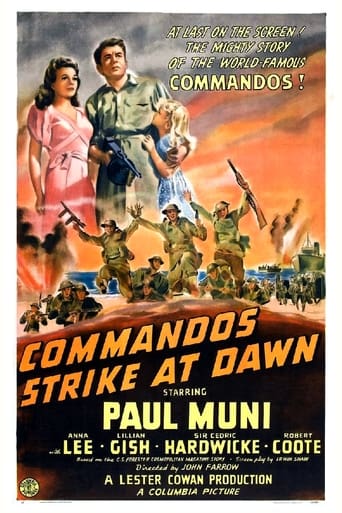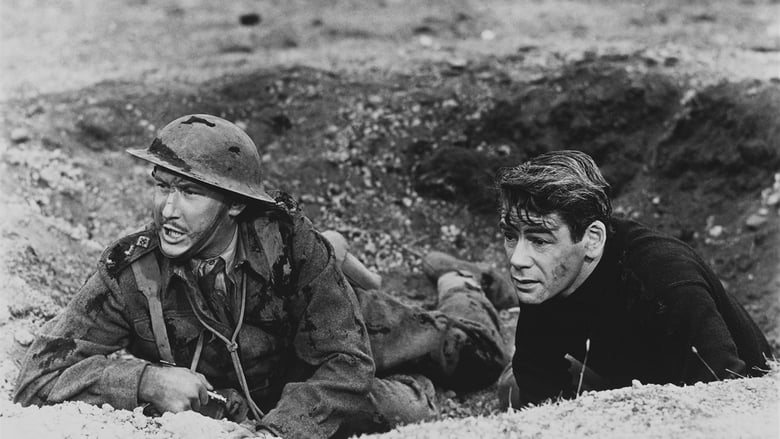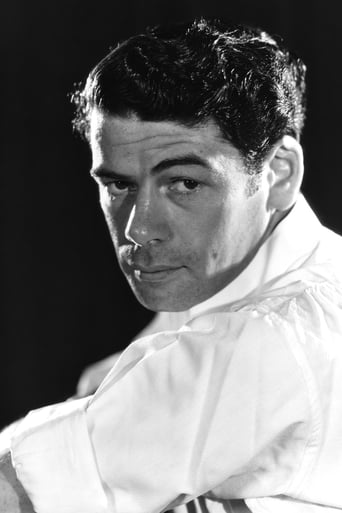Commandos Strike at Dawn (1942)
A gentle widower, enraged at Nazi atrocities against his peaceful Norwegian fishing village, escapes to Britain and returns leading a commando force against the oppressors.
Watch Trailer
Cast


Reviews
The title here is a bit of a come-on, as there is actually very little action and the script is inclined to be slow-moving. Also Paul Muni's character is not supplied with a direct motive for the commandant's murder. True, there is some tension, but less talk and more action would have helped. Fortunately, the movie starts well. The first ten minutes are really great. True, director John Farrow tries hard to keep building up suspense despite the handicaps of stilted dialog and miscasting in crucial roles - for instance, instead of playing the sadistic German commandant, George Macready plays the local schoolmaster! Actually, Alexander Knox would have been ideal in this role, but instead he is cast as the vicious German captain! This odd miscasting is shown up when it's Knox who says the chaplain's prayer before the commando raid, and Knox again who supplies the off-camera propaganda plug at the film's conclusion about corruption in high places.Paul Muni tends to overact and is often indulgently shown in close- up where his penchant for eye-rolling gets full rein. Sir Cedric Hardwicke is surprisingly stiff as the admiral and Anna Lee makes a rather colorless daughter. Despite making a strained attempt to speak and look like a hearty Norwegian, Ray Collins, comes across strongly as the tortured Bergerson, but Lillian Gish plays his wife with an over-theatrical technique that approaches caricature. Oddly enough, the most convincing performance comes from Flying Officer Robert Coote (though don't let this billing confuse you. Coote was a professional actor who had been making movies since 1931!)The script is inclined to be slow-moving. The title, for instance, is a misnomer as there is very little action apart from the climactic raid.
That's what this Norwegian fishing village is told by the arriving Nazis within minutes after being informed it would be "life as normal". Nazi normal means giving up all of your extra blankets, not being allowed to sing your own national anthem and allowing the Nazis access to your place of residence any time they knock (if they knock).Practically the same story as Warner Brothers' slightly better "Edge of Darkness", this was made first, and is an entertaining resistance drama with a superb cast, some patriotic speeches and a rousing finale. What I noticed is that much of the dialog has the innocence of a child's prayer with many of the adults speaking as if they were pre-teens while the adults of "Edge of Darkness" were clearly more mature and less stereotypical provincial. Still, with Paul Muni as the leading head of the resistance, there are some gripping moments, particularly the scene where Muni discovers that one of the Norweigans plans to use a dog whistle to notify the Nazis of their intended escape to England. Then there is the tense moment where Muni and his daughter hide in the well of a Norwegian woman who has been informed by the Nazis that her own grandson will be executed if Muni isn't caught.The lovely Anna Lee plays a British noblewoman who is visiting the town in the opening scene for a wedding and encounters Muni when he makes it to England. To think that this lovely actress (around in British films since the 1930's) wouldn't become a superstar until she took on the long-role of the beautiful Lila Quartermain on "General Hospital" is hard to believe. Her on-screen charm is winning and her film career is certainly worth a further look at outside the overly friendly neighbor from "Whatever Happened to Baby Jane" and the cheery nun in "The Sound of Music".The silent screen legend Lillian Gish is wasted in a pointless role as the long-suffering wife of the independent thinking Ray Collins who is extremely moving in a scene where he is released from a Nazi prison. (Gish's role is basically the same as Ruth Gordon's devoted wife in "Edge of Darkness", with less screen time.) Sir Cedric Hardwicke, who would be leading the Nazis into Norway in 1943's "The Moon is Down", plays the British leader here who happens to be Lee's father. Here, the villain is Alexander Knox who would go onto be an American hero in title title role of "Wilson". My personal favorite moments are the book-burning sequence where one of the Norweigans tells the Nazi standing over the burning pages that he too has written a book and hopes that one day they'll burn that one (a real slap in the face to the Nazi standing there) and the giggling children who refuse to stop singing their National Anthem as the Nazis raise their flag.
Columbia delivered an interesting war propaganda film during WWII and COMMANDOS STRIKE AT DAWN, with Canada substituting for the Norwegian coastline. Although a little overlong and slowly paced at the start, it builds interest about midway and then never lets up being an absorbing war melodrama. PAUL MUNI is a Norwegian fisherman who flees Norway after a witnessing a cold-blooded killing and then returns from Britain to take on the Nazis as a resistance fighter. The romantic angle has him in love with the Admiral's daughter, ANNA LEE.The story opens in the blissful peacefulness of a Norwegian village, circa 1939 where Muni and Lee are enjoying the pleasantries of a wedding party and it soon becomes apparent that the scriptwriter Irwin Shaw spends too much time setting up the growing romance between Muni and Lee under John Farrow's leisurely direction. One can only hope that the pace of the story will quicken once the drums of war start beating and the Germans have started their invasion of surrounding countries.Muni is understandably upset when he witnesses the murder of a young fisherman and the aftermath of a brutal beating by one of the townsmen (RAY COLLINS), and when he sees what the German invaders (led by Alexander KNOX) are doing to his village and that his young daughter (ANN CARTER) is being taught at school to hate non-Germans. On the debit side, LILLIAN GISH, as Collins' wife, has little to do but look worried. Stalwart ROD CAMERON is improbably cast as a Lutheran pastor who has to stand by while a young man is shot by a firing squad.It takes a good forty minutes into the story before the resistance tactics start to kick in and Muni begins his vengeful acts against the Nazis. A scene involving Muni hiding in a well with his small daughter while the Nazis search his home is especially well handled. Muni's escape to England is the highlight of the story, a suspenseful scene involving one of the six men who is willing to betray them to the Nazis but whose plan has to be foiled by Muni's quick thinking action.In England, Muni renews his relationship with the Admiral's daughter and the story moves toward a satisfying, if predictable, conclusion. All the performances are first rate, and after a slow start, the picture builds suspense, especially throughout the last half of the film dealing with the escape from Norway. The final skirmish at the airfield with the British taking the Nazis by surprise is as well staged as any action sequence in war movies of this era.Not the best resistance story I've ever seen, but it's worthwhile for some very moving scenes and Muni's fine, understated performance as the determined Norwegian leader.
The film was particularly interesting for me as my father was stationed at the Canadian/RAF base in 1942 on Vancouver Island. He mentioned how gracious the star's were and that they took the time to visit the lads who were busy flight training. I have recently read an old RAF magazine called (The Patrician)about director, John Farrow and actor Paul Muni being livid after a British extra ruined a battle scene by laughing hysterically in front of the camera. The area of the secret German camp is actually a military/civilian firing range and is still active today. A set of over grown cement stairs that the Commando's used as they struggled up a steep bank can still be seen in the beautiful Saanich Inlet from the water 64 years later.







